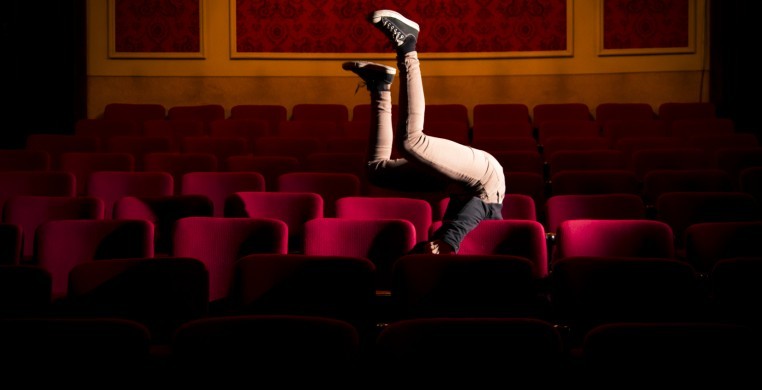The Leopold Group and The Space/Movement Project have a lot in common, but are nothing alike. Both are nine-year-old dance companies made entirely of women, experiencing a somewhat recent significant turnover of dancers. In many ways, seeing different faces has revitalized the two companies, who came together for a shared weekend surrounding the theme of watching called Witness.
In an effort to analyze the practice of witnessing dance, the upper stage of the Ruth Page Center is undressed to allow for alternative seating. As a result, sitting in the galley means not only watching the dancing, but watching others watching the dancing too. It’s hard to say what the experience of the audience members onstage may be without having done it; do they still feel “performed to” even though much of the dancing was projected to the main house? Do they feel dramatically outnumbered by the patrons watching from the other side? Are they more aware of their own movements and behaviors during the performance and/or alter their natural choices on account of being watched?
Though the backdrop of people was mostly dim and muted from view, it was clear that the watchers upstage had different reactions to the two pieces presented. Duh… as they should! Though these two companies grew up together, they speak entirely different languages. Perhaps these differences are a result of aesthetic values, perhaps directorial structure, perhaps both. Whereas The Space/Movement Project is a collective of dancers committed to a wholly shared creative process, in which everyone makes every decision together, The Leopold Group is clearly led by its namesake, Lizzie Leopold. While her dancers contribute material, Leopold ultimately makes all the decisions, from props and choreography down to the signature leotards routinely employed as costumes.
Leopold’s Lips of Their Fingers (2010) is a revisitation of an older work originally presented at The Drucker Center. This playful romp benefitted from a more formal venue, which compliments Leopold’s staging of astroturf and white twinkle lights. Also fortunate is her decision to mash the work with a newer piece featuring solo dancer Amanda Dye supported by four dancers dressed in the aforementioned twinkle lights. Up to that point, we are treated to the cheeky quirk of gestural modern dance performed to the Beastie Boys; a dramatic shift to soft lighting and a Chopin piano score is welcomed, and quite poignant. The group’s performances, however, lack consistency. On occasion the dancers turn their focus internally, appearing distracted - as if trying to remember the steps. This piece works best (and really, really well) when the dancers are fully committed to playfulness among themselves and the audience.
The Space/Movement Project had something entirely different to offer with the premiere of The Dismantlers. This shift was felt in the audience members on the upper stage - body postures and facial expressions changed to adapt to a polar experience wrought with obscurity and esotericism.The Dismantlers takes its time, developing slowly and deliberately, and finding a few distinct moments of resolution. We might have had more patience for such a diligent exploration having not just jammed out to the Beastie Boys for the better portion of an hour, but admittedly, it was a bit of a struggle. Perhaps it is the shared choreographic process, or perhaps the influence of a largely shapeless sound score - The Dismantlers is a beautiful, meditative, bewitching road that leads to nowhere. The impact of several new dancers in the cast is undeniable, and it’s rather fascinating to witness seasoned performers the likes of Allyson Esposito, Anne Kasdorf and Leah Raffanti juxtaposed with fresh neophytes. As The Space/Movement Project enters its second decade of dancemaking, it will be interesting to observe how these new voices come to play.
Lauren Warnecke, March 30, 2014

